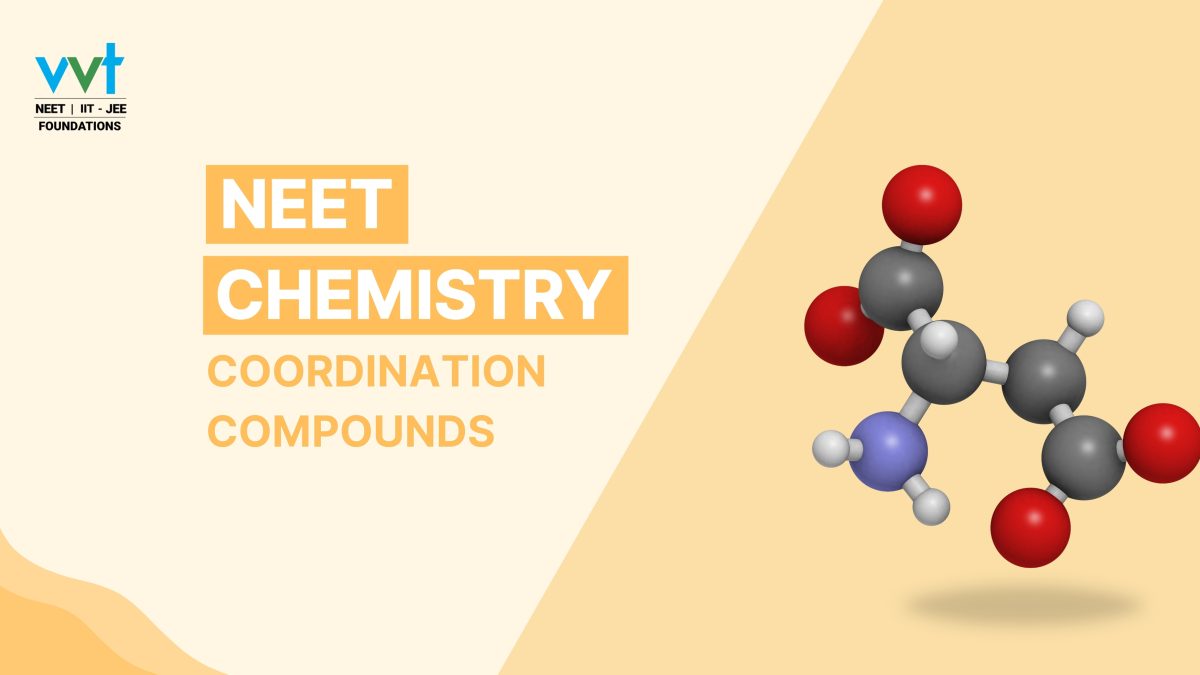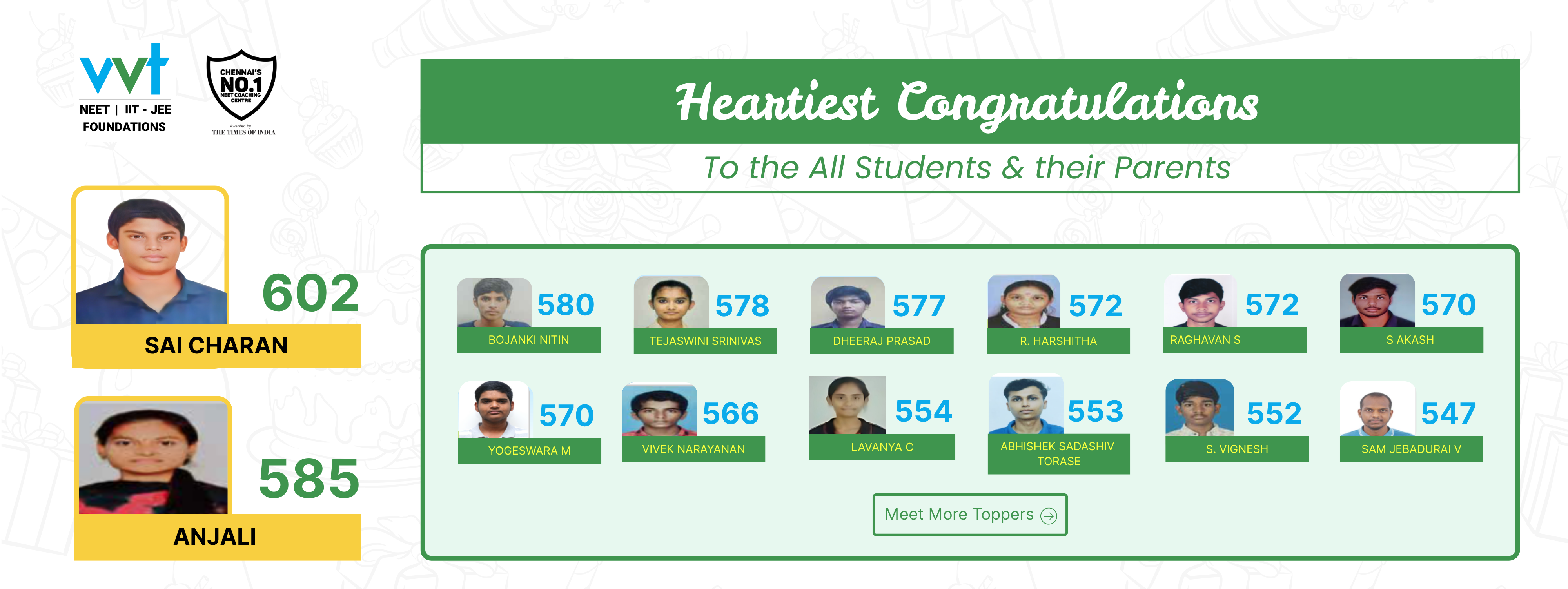
Aldehydes, Ketones, and Carboxylic Acids for NEET: A Deep Dive into Named Reactions and Mechanisms
March 8, 2025
NEET Eligibility for Open School Students 2025: A Complete Guide by VVT Coaching
March 13, 2025NEET Coordination Compounds: A Complete Guide to IUPAC, VBT, and CFT
VVT Coaching Chennai – Ranked #1 Best NEET Coaching Centre by Times Now!
At VVT Coaching, we empower NEET aspirants to excel in Inorganic Chemistry, a vital component of the NEET syllabus. This comprehensive guide delves into Mastering Coordination Compounds for NEET, focusing on essential concepts like IUPAC nomenclature, Valence Bond Theory (VBT), and Crystal Field Theory (CFT).
These topics carry significant weightage in the Chemistry section of the NEET exam, and a strong grasp of them can greatly elevate your score. With clear explanations, expert insights, and practical study strategies, we’ve crafted this resource to simplify these complex ideas and set you on the path to success. Dive in and take a confident step toward acing NEET!
Why Coordination Compounds Matter for NEET
Coordination Compounds are a vital part of Inorganic Chemistry in NEET, frequently appearing in MCQs on naming, bonding, and properties. Excelling in this topic can give you a competitive edge. Here’s what we’ll cover:
- Coordination Compounds: Structure, ligand types, and geometry.
- IUPAC Nomenclature: Rules for naming complexes systematically.
- Valence Bond Theory (VBT): Bonding between metals and ligands via hybrid orbitals.
- Crystal Field Theory (CFT): Ligand effects on d orbital splitting, color, and magnetism.
Let’s break it down step by step.
Section 1: Basics of Coordination Compounds
Coordination compounds are complexes where a central metal atom or ion is surrounded by ligands—molecules or ions donating electron pairs. Picture the metal as the centerpiece, with ligands orbiting around it.
For NEET, focus on their structure, coordination number, and geometry.
Key Terms
- Central Metal Atom/Ion: The heart of the complex (e.g., Co³⁺ in [Co(NH₃)₆]Cl₃).
- Ligands: Entities bonded to the metal (e.g., NH₃, Cl⁻).
- Coordination Number: Number of ligands attached (e.g., 6 in [Co(NH₃)₆]Cl₃).
- Geometry: Shape determined by coordination number (e.g., octahedral for 6 ligands).
Types of Ligands
- Neutral: No charge (e.g., NH₃, H₂O).
- Anionic: Negative charge (e.g., Cl⁻, CN⁻).
- Chelating: Ligands forming multiple bonds (e.g., EDTA).
Common Coordination Compounds
| Compound | Central Metal | Ligands | Coordination Number | Geometry | Magnetic Property |
| [Co(NH₃)₆]Cl₃ | Co³⁺ | NH₃ | 6 | Octahedral | Diamagnetic |
| [Cu(NH₃)₄]SO₄ | Cu²⁺ | NH₃ | 4 | Square Planar | Paramagnetic |
| [Fe(CN)₆]⁴⁻ | Fe²⁺ | CN⁻ | 6 | Octahedral | Diamagnetic |
| [Ni(CO)₄] | Ni⁰ | CO | 4 | Tetrahedral | Diamagnetic |
Section 2: Mastering IUPAC Nomenclature
IUPAC nomenclature is the standardized method for naming coordination compounds, a critical skill for NEET. Here’s the breakdown
Naming Rules
1.Ligands First: List alphabetically with prefixes (e.g., di-, tri-) for multiples.
2.Central Metal: Named after ligands, with oxidation state in Roman numerals.
3.Complex Type: Use -ate for anionic complexes (e.g., [Fe(CN)₆]⁴⁻ becomes hexacyanoferrate(II)).
Examples
.Cationic Complex: [Co(NH₃)₆]Cl₃ → Hexaamminecobalt(III) chloride.
.Neutral Complex: [Ni(CO)₄] → Tetracarbonylnickel(0).
.Anionic Complex: K₄[Fe(CN)₆] → Potassium
hexacyanoferrate(II).
Ligand Names and Charges
| Ligand | Name in Complex | Charge |
| NH₃ | Ammine | 0 |
| Cl⁻ | Chloro | -1 |
| CN⁻ | Cyano | -1 |
| H₂O | Aqua | 0 |
| CO | Carbonyl | 0 |
Common Mistakes: Misordering ligands or omitting oxidation states.
VVT Coaching Tip: Practice naming with past NEET questions, such as “Name [Pt(NH₃)₂Cl₂].
Section 3: Understanding Valence Bond Theory (VBT)
VBT explains how the central metal uses its orbitals to bond with ligands through hybridization.
It’s essential for predicting shape and magnetic properties.
How VBT Works
The metals d, s, and p orbitals hybridize to accept ligand electron pairs.
- .Inner Orbital Complexes: Use (n-1)d orbitals (e.g., d²sp³ in [Co(NH₃)₆]³⁺, low spin, diamagnetic).
- .Outer Orbital Complexes: Use nd orbitals (e.g., sp³d² in [CoF₆]³⁻, high spin, paramagnetic).
Magnetic Properties
- Diamagnetic: No unpaired electrons (e.g., [Co(NH₃)₆]³⁺).
- Paramagnetic: Unpaired electrons present (e.g., [CoF₆]³⁻).
Comparison Table:
| Feature | Inner Orbital | Outer Orbital Complex |
| Hybridization | d²sp³ | sp³d² |
| d Orbitals Used | (n-1)d | nd |
| Example | [Co(NH₃)₆]³⁺ | [CoF₆]³⁻ |
| Spin State | Low spin | High spin |
| Magnetic Property | Diamagnetic | Paramagnetic |
Practice Question: Find the hybridization and magnetic property of [Fe(CN)₆]⁴⁻.
Section 4: Decoding Crystal Field Theory (CFT)
CFT describes how ligands split the metal’s d orbitals, impacting color and magnetism. It’s a step up in complexity but vital for NEET.
How CFT Works
- In octahedral complexes, d orbitals split into lower-energy t₂g and higher-energy e.g. orbitals.
- In tetrahedral complexes, splitting reverses, with e and t₂ sets.
High Spin vs. Low Spin: Strong field ligands (e.g., CN⁻) pair electrons (low spin), while weak field ligands (e.g., F⁻) leave them unpaired (high spin).
Factors Affecting Splitting
- Ligand field strength (spectrochemical series).
- Metal ion and oxidation state.
Ligand Field Strength Table
| Ligand | Strength Effect | Effect on Complex | Example Complex |
| CN⁻ | Strong | Low spin | [Fe(CN)₆]⁴⁻ |
| CO | Strong | Low spin | [Ni(CO)₄] |
| NH₃ | Moderate | Variable | [Co(NH₃)₆]³⁺ |
| H₂O | Weak | High spin | [Fe(H₂O)₆]²⁺ |
| F⁻ | Weak | High spin | [CoF₆]³⁻ |
VVT Coaching Tip: Use CFT to tackle questions on color and magnetism, like why [Cu(H₂O)₆]²⁺ is blue.
Section 5: Comparing VBT and CFT
- VBT: Emphasizes bonding and hybridization, great for geometry.
- CFT: Focuses on d orbital splitting, color, and magnetism.
- When to Use: VBT for basic bonding, CFT for advanced properties.
Practice Question: Compare VBT and CFT for [Co(NH₃)₆]³⁺.
Section 6: Study Tips from VVT Coaching
Boost your preparation with these strategies:
- Prioritize: Focus on IUPAC naming (2-3 questions) and VBT/CFT (3-4 questions).
- Use NCERT: Your go-to resource—master it completely.
- Practice Regularly: Solve 10-15 past NEET questions daily.
- Time Management: Target 1 minute per question in practice.
Resource Recommendations:
- NCERT Chemistry (Class 12).
- JD Lee for deeper understanding.
- VVT Coaching’s Crash course materials.
Download and practice free MCQs
| NEET Coordination Compounds | ||
| Question | Answer Key | Solutions |
| Coordination chemistry questions | Coordination-compounds-answer-key | Coordination-compounds-solutions |
| coordination-compounds-question | coordination-compounds-answer | coordination-compounds-solutions |
Conclusion: Mastering Coordination Compounds with VVT Coaching
Success in NEET relies heavily on a solid command of Inorganic Chemistry, especially the pivotal topics of Coordination Compounds, encompassing IUPAC nomenclature, Valence Bond Theory (VBT), and Crystal Field Theory (CFT).
These concepts are more than just syllabus checkpoints—they’re your key to unlocking high-weightage questions that can significantly boost your score. To truly excel, rote memorization won’t cut it; you need a strategic study approach, regular practice, and expert insights to navigate the complexities of these topics with confidence.
At VVT Coaching Chennai, we’re dedicated to simplifying these challenging subjects and making them approachable for every NEET aspirant. Our experienced faculty provides structured study plans, personalized mentoring, and premium resources designed specifically to help you master Coordination Compounds. With our support, you’ll gain a thorough understanding of IUPAC naming conventions, the bonding principles of VBT, and the electronic intricacies of CFT, empowering you to tackle NEET-level questions with precision and ease.
Seize the opportunity to elevate your NEET preparation and join VVT Coaching Chennai today.
Let us guide you step-by-step toward mastering these essential topics and paving the way to your dream medical career!
Visit us at vvtcoaching.com to get started.
Also check:
.NEET Chemistry Chapter-wise and Concept-Wise Weightage
.NEET Chapter Wise Weightage 2025: Complete Guide with Important Chapters
.Last 60 Days NEET Strategy: Smart Revision Tactics
FAQs for NEET Students
A compound with a central metal atom/ion bonded to ligands, like [Co(NH₃)₆]Cl₃.
How do I name complexes using IUPAC?
List ligands alphabetically, then the metal with its oxidation state, e.g., Hexaamminecobalt(III) chloride.
What’s the difference between high spin and low spin complexes?
High spin has more unpaired electrons; low spin has paired electrons, based on ligand strength.
How can VVT Coaching help?
We provide expert guidance, concise notes, and personalized support to ensure NEET success.












